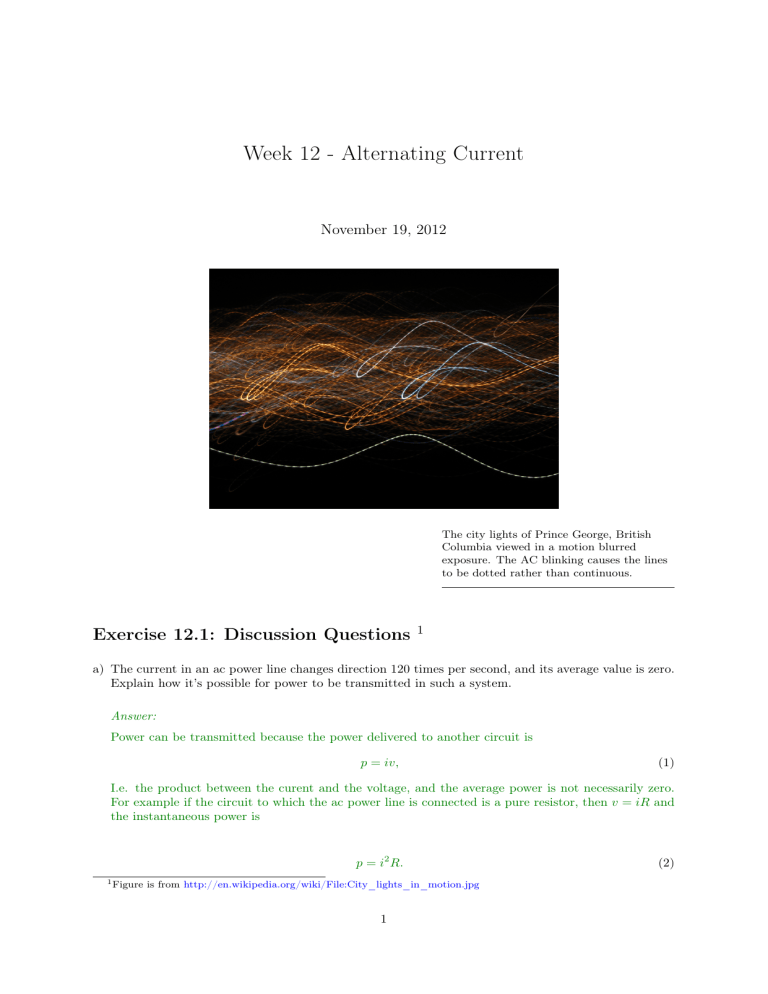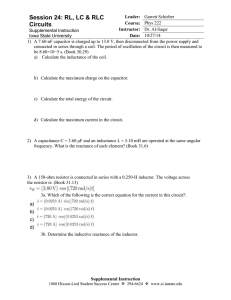Week 12 - Alternating Current

Week 12 - Alternating Current
November 19, 2012
The city lights of Prince George, British
Columbia viewed in a motion blurred exposure. The AC blinking causes the lines to be dotted rather than continuous.
Exercise 12.1: Discussion Questions
a) The current in an ac power line changes direction 120 times per second, and its average value is zero.
Explain how it’s possible for power to be transmitted in such a system.
Answer:
Power can be transmitted because the power delivered to another circuit is p = iv, (1)
I.e. the product between the curent and the voltage, and the average power is not necessarily zero.
For example if the circuit to which the ac power line is connected is a pure resistor, then v = iR and the instantaneous power is p = i
2
R.
1
Figure is from http://en.wikipedia.org/wiki/File:City_lights_in_motion.jpg
1
(2)
This is always positive which means that power is dissipated in the resistor at any moment. The average power is given by
P av
=
1
2
I
2
R.
(3) b) Fluorescent lights often use an inductor, known as ballast to limit current through the tubes. Why is it better to use inductor than a resistor for this purpose?
Answer:
One reason that the inductor is preferable over the resistor is that the average power dissipated in the inductor is practically zero. This means that we dont waste precious energy on just limiting the current so that everything can go into producing visible light.
The applied voltage does work on the current as the back emf resists a rising current, this energy is then stored in the magnetic fields of the inductor and given back when the emf of the inductor does work on a decreasing current.
c) A light bulb and a parallel-plate capacitor with air between the plates are connected in series to an ac source. What happens to the brightness of the bulb when a dielectric is inserted between the plates?
Explain.
Answer:
The impedance of the circuit goes down as the dielectric is inserted so the current amplitude goes up and more power is delivered to the bulb. Therefore the bulb glows brighter. Mathematically this is seen by looking at the expression for the impedance of the circuit
Z = q
R 2 + X 2
C
= s
R 2 +
1
ωC
0
2
(4)
Now as the dielectric is inserted the capacitane of the goes to C = KC
0 where K is the dielecric constant and since K > 1 the capacitive reactance goes down. Physically what happens is that when the dielectric is inserted, the dipoles in the dielectric is aligned in such a way that they create an additional elecric field which opposes the original. The electric field weakens which allows more charge to accumulate on the plates for the voltage provided by the ac source. The consequence of the capacitor allowing for a greater amount of charge to accumulate is that a greater current can flow in the circuit.
d) Can a transformer be used with dc? Explain. What happens when a transformer designed for 230 V ac is conneced to a 230 V dc line?
Answer:
No it can not! One of the great advantages of ac over dc is that voltages can be stepped up and down using a transformer. This allows for high voltage transmission which very effectively reduces energy loss due to heating of transmission wires.
If you connect a dc line to any transformer it will not do anything for you. The primary will not even deliver an emf to the secondary. This is because the emf in the secondary was created by a
2
flux change trough it’s coil. With no changing current we won’t have changing magnetic fields and therefore no changing flux.
Exercise 12.2: Off to the USA!
You take your hair blower off the USA, where the electrical outlets puts out 120 V (rms) instead of the
230 V (rms) found here in Norway. The blower puts out 1600 W (average) at 230 V .
a) What could you do to operate your blower via the 120 V line in USA?
Answer: Get a transformer with the ratio
N
2
=
N
1
V
2
=
V
1
12
23
.
(5) b) What current will your blower draw from an outlet in USA?
Answer:
I = 13 .
3 A (6) c) What resistance will your blower appear to have when operated at 120 V ?
Answer:
R ef f
= 332 .
5 Ω .
(7)
Figure 1
Exercise 12.3: The L-R-C Parallel Circuit
A resistor, inductor, and capacitor are connected in parallel to an ac source with voltage amplitude V and angular frequency ω
. This is shown in figure 1. Let the source voltage be given by
v = V cos ωt .
3
a) Show that the instantaneous voltages v
R
, v
L and v
C at any instant are equal to i
R
+ i
L
+ i
C
, where i is the current through the source and i resistor, inductor and capacitor, respectively.
R
, i
L and i
C v and that i = are the currents trough the b) What are the phases of i
R
, i
L and i
C with respect to v ? Use current phasors to represent i , i
R
, i
L and i
C
. In a phasor diagram, show the phases of these four currents with respect to v .
c) Use the phasor diagram in (b) to show that the current amplitude I for the current i trough the source is given by
I = q
I 2
R
+ ( I
C
− I
L
) 2 .
(8) d) Show that the result of part (d) can be written as I = V /Z with
1
Z
= s
1
R 2
1
+ ωC −
ωL
2
.
(9)
Answer:
1
Z
= s
1
R 2
1
+ ωC −
ωL
2
.
(10)
Exercise 12.4:
An L-R-C parallel circuit is connected to an ac source of constant amplitude V and variable angular frequency ω .
a) Find expressions for the amplitudes I
R
, I
L capacitor as functions of ω .
and I
C of the currents through the resistor, inductor and
Answer:
I
R
=
V
R
, I
L
=
V
ωL
, I
C
= ωCV.
(11) b) Graph I
R
, I
L and I
C as functions of ω for V = 200 V , R = 50 Ω , L = 1 .
0 H and C = 20 µ F .
Answer: c) Discuss the behaviour of I
L why they do in these limits.
and I
C in the limits ω → 0 and ω → ∞ . Explain why I
L and I
C behave d) Calculate the resonance frequency (in Hz ) of the circuit, and sketch the phasor diagram at resonance.
What is the current amplitude trough the source at this frequency?
Answer: f
0
= 36 .
6 Hz (12)
4
Figure 2
I =
V
R
= 4 .
0 A .
(13) e) At the resonance frequency, what is the current amplitude trough the resistor, through the inductor and trough the capacitor?
Answer:
I
L
= I
C
= 146 mA (14)
I
R
=
V
R
= 4 A .
(15)
Exercise 12.5: A High-Pass Filter
One application of of L-C-R series circuits is to high-pass or low-pass filters, which filter out either the
(filtered signal) is taken out between the a and b terminals. Derive an expression for V out
/V , the ratio of the output and source voltage amplitudes, as a function of the angular frequency ω of the source.
Show that when ω is small, this ratio is proportional to ω and thus also is small. Show that the ratio approaches unity as the frequency gets large (The signal passes trough unaffected at large frequencies).
5
Figure 3
Figure 4
6




